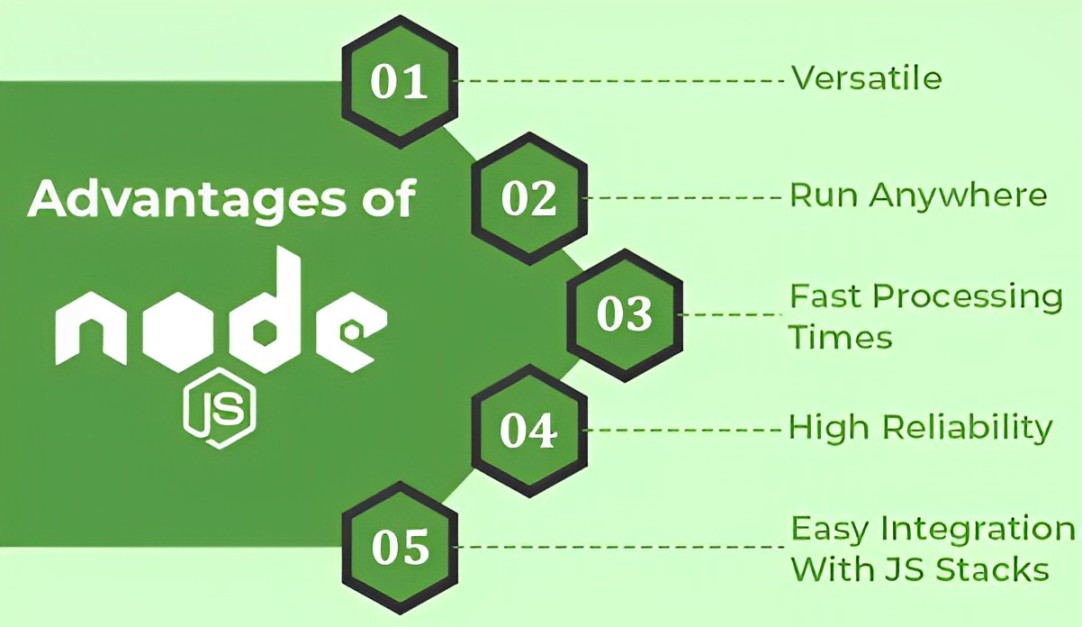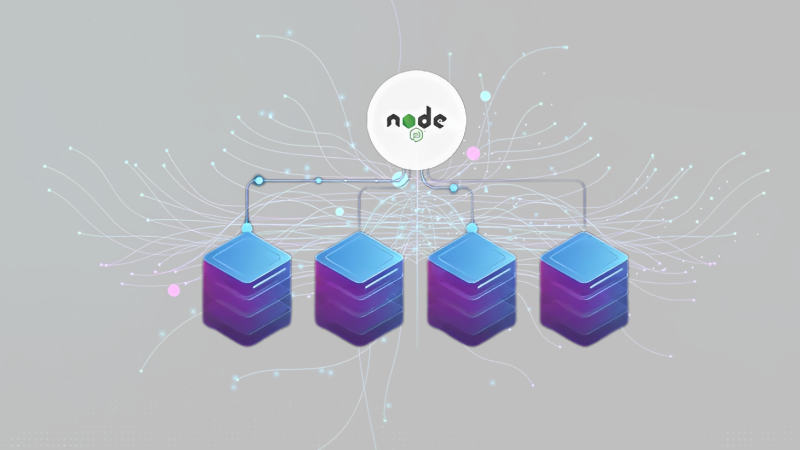What is Serverless Nodejs?

Image source: https://tsh.io/blog/serverless-in-node-js-case-study/
Node.js is a big platform that was constructed using a variety of fascinating building components. As a result of a lack of knowledge of how these fundamental components of Node.js operate, many Hire nodejs web developers make erroneous assumptions about the behavior of Node.js. As a result, they create apps that result in significant performance difficulties as well as errors that are difficult to trace.
The advantages of Serverless computing are discussed here
Serverless computing is bringing about a sweeping change in the manner in which programs are developed and deployed. A game-changing innovation for software makers is Serverless architecture, which has evolved as a result of the advent of cloud computing. We are going to dig into the multiple advantages of Serverless computing and investigate the notion of Serverless computing in this part.
Historically, when it came to the development of applications, programmers were required to be concerned with the management of servers, the supply of resources, and the scaling of infrastructure to handle many workloads. This needed a large amount of effort and time, which diverted attention away from the creation of the main product.
On the other hand, Serverless computing frees developers from the burden of having to worry about foundational components, enabling them to concentrate exclusively on developing code. Developers can construct and deploy apps without having to worry about managing servers or scaling facilities.
In what way does Node.js function?
When contrasted with other programming platforms, the workflow technique applied by Node.js is singular. This feels that it will not generate a newer thread for all requests which is made since it functions on a single thread. A thread is essentially a collection of guidelines that the server is obligated to carry out within its own time.
The procedure is carried out in this technique: whenever the request is submitted via the client to the website server, the single-threaded event loop automatically retrieves it and then transmits it to the worker thread that is now active for processing.
In other words, it makes use of non-blocking input/output procedures. There is the ability for a single process to fulfill many requests at the same time, thanks to sequential I/O operations. Node.js proceeds to work on another task rather than waste CPU resources and stop the thread by waiting for a response. Additionally, it does not wait for a response. Therefore, it can manage numerous jobs in just some time.
Node.js Architecture
The Node.js architecture is comprised of several fundamental components, some of which are listed below.
1. Single Thread
In its most basic form, Node.js functions on a single thread. This indicates that it is capable of managing several customers at the same time. Also, this strategy is a fantastic option to take into consideration since it prevents context flipping.
2. Loop of Events
Even though it has the single-threaded characteristic, the event loop in node.js is still able to carry out the non-blocking I/O operations. Libuv, which is responsible for handling the queuing and processing of events that occur asynchronously, serves as the foundation for the event loop.
3. Requests operation
It is entirely dependent on the operation that the user wants to carry out in a web application as to whether the incoming requests are blocking (complicated) or non-blocking (simple).
Understand the Functions That Node.js Offers
Some of the most valuable features are found in Node.js. We have provided a list of a few here.
1. Easy to Be Taught
One could quickly understand Node.js if you are acquainted with JavaScript, as one could see. It is common knowledge that JavaScript is the language of choice for designers, which is why it is pretty well-known and regularly applied.
The procedure of writing code with the help of Node.js is even relatively straightforward. You can understand and function with Node.js in a shorter time.
2. When it comes to speed, it is optimal
For a website or application to be successful, speed is the most critical component! Based on Google Chrome’s V8 JavaScript Engine, which is very quick the development of Node.js was to execute programs written in JavaScript.
3. Compatibility Across Multiple Platforms
When it comes to programming languages, developers often choose those that are interoperable with several platforms. The fact that Node.js is interoperable with a diversity of operating systems, including Linux, Windows, UNIX, and Mac OS, as well as mobile platforms, is often regarded as one of the most astounding aspects of this technological advancement. Because of this, it is feasible to run Node.js on any of these different kinds of computers.
4. Free and Open Source
The Node.js platform might be used at any moment with no incurring extra expenses. It is possible to do the installation of Node.js directly from the website.
5. Widespread Communal
Node.js is a massive open-source development that is steadily expanding. Therefore, it is deserving of aid and assistance which are geared toward the progress of the platform. Developers can request assistance from members of the community for their questions.
Without incurring any additional expenses, they can exchange frameworks, tools, and packages with one another. A significant contribution to the development of frameworks like Express, Derby, Sail.js, and others has been made by the Node.js community.
6. Quite a few packages
Your project functions might be simplified with the assistance of Node.Js’ extensive collection of open-source correspondences. For the sake of clarity, it is important that the NVM bionetwork now contains one million packages. In the NVM bionetwork, there are no less than one million applications accessible for use with Node.js that are an astounding extent.
7. Individual Coding
Node.js designers are accountable for writing the JavaScript together in the client also the server. This simplifies the procedure of moving data between the server and the client, ensuring that the synchronization is as accurate as possible. The usage of single codebase approaches enables developers to save time when it comes to the creation and execution of code. This is because developers are not required to create code individually.
8. Server for Proxy
In the process of developing an application, there are times when it is necessary to establish a secret area to store data and control the behavior of users. However, if you work in a group, it may be challenging to maintain the confidentiality of the information that is stored on your computer. One approach is to make use of a proxy server that saves just HTTP headers, cookies, and other data that is not considered sensitive. When your users access an external domain name using a proxy service such as node-HTTP-proxy, they will not be aware that they are interacting with an API server since everything will behave as if it were utterly flawless.
Let us embrace the Serverless approach!
Prior knowledge of the essential processes involved in migrating a Node.js application to a Serverless architecture is crucial.
It is crucial to ensure that the application is stateless. Alternatively, if functions are not completed in processes that run for extended periods, data loss will occur. The decision of where to keep such data is in your hands. Functions provide the ability to interact with external storage sources, such as DynamoDB or Redis. The second option is very suitable for caching data owing to its exceptional speed. It is important to note that each function can use 512MB of temporary storage space inside its execution environment. It is possible to save cached data for future use, but functions must always verify the presence of appropriate data before attempting to retrieve it. The duration of its availability is uncertain.
After eliminating the state, the subsequent action is to parameterize the application if it has not been done before. An optimal approach involves using environmental variables, which may be safely accessed and used for AWS Lambda functions via the AWS Systems Manager Parameter Store.
Although not mandatory, the following action may significantly enhance the usability of the program. Storage abstraction enables the injection of appropriate storage implementations using dependency injection containers based on the specific environment. To streamline the process, the in-memory storage may be used for local development and testing. Actual databases may be used in a live environment after the storage implementation is changed to a different one. Regrettably, this strategy has two primary disadvantages. By using this software development approach, you may eliminate potential problems and avoid encountering them during the production phase.
How the Serverless Node.js architecture works with benefits

Image source: https://www.tatvasoft.com/outsourcing/2022/03/asp-net-core-vs-node-js.html
Harnessing the benefits of Serverless Node.js is possible with the best practices and a little understanding of its architecture. It is a versatile choice for developers to handle tasks that need scaling. They only need to pay attention to coding, and this makes it an efficient option.
The core benefits also lie in:
- Cost reduction
- Full features for scalability
- Development at a quicker pace
- Project completion on time
- NPM system for writing code
- Deployment on the platform of choice
In detail
- Companies may investigate the possibility of outsourcing non-core tasks to third-party contractors who are experts in those particular fields.
- Having access to all of the capabilities that are available to you may make a significant impact on the development and success of your project or company organization.
- The ability to perform efficiently in a fast-paced atmosphere and contribute to making your job more bearable and fun is essential.
- It is possible for developers to quickly share their packages with the community via the use of Npm, which encourages cooperation and the exchange of information. Without best practices, the benefits are meaningless.
The ideal course of usage of a Serverless Noce.js architecture offers a degree of optimization. Its classic advantages include:
- Overall performance with critical functions and cold start-up times.
- Safe configuration values with the environment variables.
- Automated testing options.
- Asynchronous operations are helpful for multi-tasks and operations.
- Easy ways to troubleshoot, log, and monitor for agile performance.
Node.js is powerful in real-world cases as it has an event-based design architecture. It is natural and aligns with the principles of Serverless usage. All applications created respond despite the workloads. Scalability is a crucial factor, and coding practices are well-defined. It can harness the DevOps and strategic development cycles. They are crucial for granular function management.
Bottom Line
In conclusion, the integration of Serverless architecture with Node.js has proved to be a game-changer for a significant number of enterprises operating in a variety of different sectors. Presented above are several instances that illustrate the disruptive influence that Serverless Node.js applications may have, opening the way for inventiveness, expansion, and cost savings via their implementation. Companies can unleash a new age of application creation and harness every advantage of Serverless computing if they adopt this technology and put it to use.
Learn how multithreading in Node.js can handle parallel execution and optimize your workflows.



